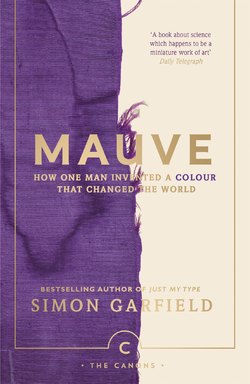Читать книгу Mauve - Simon Garfield - Страница 15
На сайте Литреса книга снята с продажи.
ОглавлениеChapter Five
Hindrance and Synthesis
Patrick mixed paints – a delicate shadowy mauve, a scarlet, a rich blue, a pale sharp green. The paintings, when they arrived, were done suddenly and fast. I watched, from inside my head. Patrick would always smile apologetically, and both of us would laugh nervously, and then his face would set into a detached, slightly furious look, and he would take a stab at the canvas, and then a rush.
A square head appeared, and a decorative trellis of flowers. Various faces, shadowed in the delicate mauve, existed for a moment, and then were wiped away. I was fascinated by how the ghosts of the expunged forms continued to exist and to make the subsequent versions more complex and substantial. Purple is Patrick’s favourite colour. It is not mine. But I became entranced by the shadowy half-depths of that particular mauve running across the canvas.
A. S. Byatt on being captured by Patrick Heron,
Modern Painters, 1998
The way Robert Pullar remembers it, William Perkin arrived in Perth, Scotland, in the early winter of 1856 with some problems on his mind. He explained to Pullar that he had severe doubts about his decision to leave the steady world of research for one of commercial industry. He had misgivings about his ability to compete in business, and this insecurity led to more fundamental concerns. Just how valuable would mauve be? How would dyers react to a complete change in the way colour was derived? Would anyone be willing to adapt to new methods of dyeing after employing the same techniques for generations? And although mauve successfully dyed silk, why was it proving so much harder to apply the new colour to cotton?
Writing many years later in The Dyer, Laurence Morris listed six hindrances to Perkin’s future success, a daunting tally for an eighteen-year-old, (1) There was no reason to believe that capital could be found to launch the venture. (2) There was no guarantee that dyers and printers would use the colours at all, let alone in the quantities required to justify the building of a factory to manufacture it. (3) The raw materials required to make it were largely crude chemicals in limited supply. (4) No site was available to build a factory. (5) Methods of applying the new colour to most textiles had yet to be worked out. And (6) Perkin did not have any experience of what he was about to do. In all ways, Perkin appeared to be quite out of his depth. Making a colour was one thing; bringing it to the world quite another.
To reassure each other, Perkin and Robert Pullar spent a little over two weeks conducting experiments and touring Scottish dye works. The results were disappointing. Mauve would not dye cotton without a mordant (an intermediate fixative that allowed the colour to ‘bite’ into the material). Unlike the existing vegetable dyes, mauve was not acidic, and all the existing mordants Pullar possessed failed to work on a synthetic dye; on cotton, mauve faded dramatically after each wash. The conservative printers and dye technicians they met in Glasgow were consistently brusque and dismissive. ‘Ach, ye’re wrang this time, Mr Robert,’ one printer remarked on their travels. ‘D’ye think anything will take the place o’ madder?’
‘It was a very discouraging day,’ Perkin noted as his pessimism deepened. ‘Although the colours were admired, that terrible IF respecting the cost was always brought forward.’ He estimated that he would be unable to supply purified solid mauve for less than £3 per ounce – this at a time when an ounce of platinum cost just over £1. His problem was that to make one ounce of mauve he required about 400 pounds of coal.
To his advantage, mauve appeared to be the most intense colour the dyers and printers of Scotland had seen. In one experiment, Perkin demonstrated that one part of mauve dyed 630,000 parts of water. ‘Yet the printers who tried it did not show any great enthusiasm,’ Perkin concluded, fearing that he was beginning to lose the support of his host. ‘Even Messrs Pullar began to fluctuate in their opinion as to the advisability of erecting plant for its manufacture.’
Perkin returned to London to receive a curious note from August Hofmann. Resigned to losing him as a student, Hofmann realised that he might now be useful as a supplier of materials for his own researches. ‘My dear Mr Perkin,’ he began. ‘Since you manufacture aniline now on rather a large scale, would you be so good as to let me have a quart or two of it. Of course I am most anxious to pay for it. I am very prepared for it and would thank you much for a speedy reply to this note.’ It is not known how Perkin responded. But despite Hofmann’s assumption, Perkin was having trouble securing enough aniline for his own samples.
Shortly after Christmas, Perkin received another letter, this time with positive news. Robert Pullar had found one dyer who might be supportive. ‘As I was unable to help [the application of mauve] forward myself,’ Pullar later recalled, ‘I introduced Sir William to a friend, Mr Keith, in Bethnal Green, the largest silk dyer in London at that time.’
